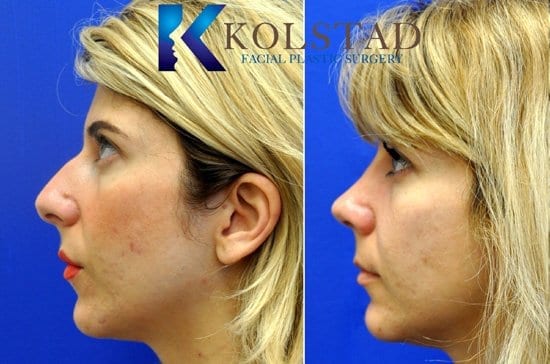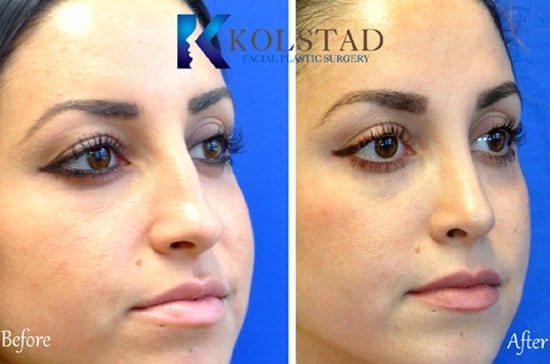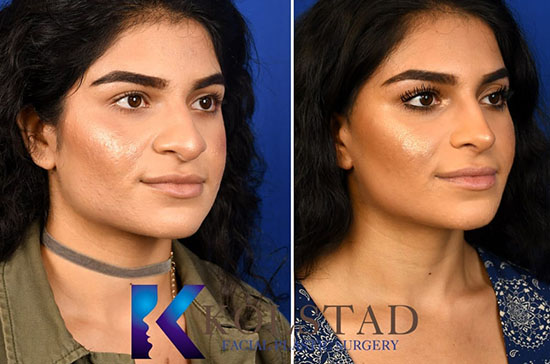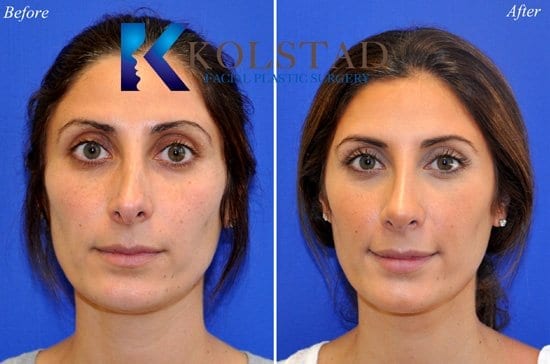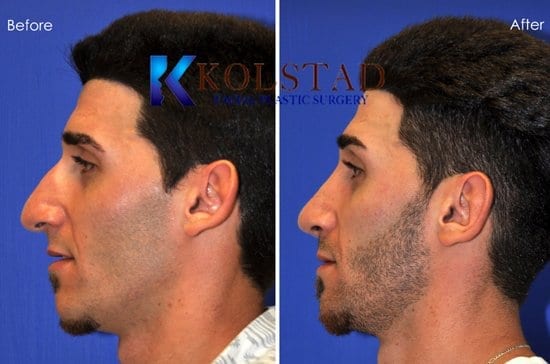Middle Eastern Nose Job Specialist | San Diego Middle Eastern Rhinoplasty Surgeon
Middle Eastern rhinoplasty is one of Dr. Kolstad’s most common procedures. San Diego has a diverse community with people from every part of the world. Many nose job surgeons will have the same rhinoplasty result for every face. Dr. Kolstad specializes in achieving unique results that match your features as well as your ethnic background.
How Are Middle Eastern Noses Different From Those Of Other Ethnicities?
Persons of Mediterranean and Middle Eastern descent can have noses that appear to be elongated and overly prominent. When examining a nose it is helpful to evaluate the individual subunits.
Nasal Tip:
Middle Eastern noses can have tips that droop or are pointed downwards. A drooping nasal tip creates an appearance of an elongated nose. By rotating the tip of the nose upwards a drooping nose can appear more refined. Increasing the amount of nasal tip rotation will make the nose appear less elongated on the profile view and less drooping on the front view.
The nasal tip is often wide and prominent on the front view. By reshaping the nasal tip cartilages the nose will appear more refined and in better balance with the other facial features.
Columella:
A hanging columella (the strip of skin between the nostrils) is another cause of a drooping nasal tip. Columellar ptosis can be corrected at the time of rhinoplasty to improve the infratip lobule (the lower part of the nasal tip). Reducing a hanging columella will make the nose appear less elongated on the profile view and less drooping on the front view.
Bridge:
Middle Eastern noses can have a prominent hump on the bridge. The hump or convexity is most visible on the profile view. Reducing the prominence of the hump can make a significant impact on the overall appearance of the nose.
Women can choose to create either a straight bridge or have a slight curvature to it. For men the most appealing appearance is a straight bridge.
Radix:
The radix is the highest part of the bridge of the nose. Middle Eastern noses can have a high radix making the bridge of the nose appear to start between the eyebrows instead of at the level of the upper eyelid. Reducing the height of the radix can be difficult to accomplish with rhinoplasty but an important part of the procedure nonetheless.
While a dissatisfying outcome in nasal cosmetic surgery is possible even in the most skilled hands, more commonly it comes from the hands of the occasional nasal surgeon. Revision rates with inexperienced physicians have been reported to be as high as 20%.
The decision to have a revision surgery can be a difficult and often emotional one. Dr. Kolstad believes in approaching the procedure as your partner. He works with you to ensure that all of your concerns are discussed and that he clearly understands your goals. Dr. Kolstad believes that those seeking revision surgery need to be advised honestly about what they can expect.
Dr. Kolstad’s analytic approach distinguishes him from his colleagues. He believes in a customized approach that is specific to the way that your nose will harmonize with your face.
Dr. Kolstad learned his technique from one of the best rhinoplasty surgeons in the world. He spent an entire year in New York working exclusively with one of the world’s premier Facial Plastic Surgeons.
“You do not learn plastic surgery from a book or by watching a video. You learn to become the best by working with the best.”
Revision nasal surgery is more challenging than primary rhinoplasty for several reasons. Patients that have had a previous surgery will have scar tissue which increases the complexity of the procedure.
During the first nasal surgery distorted cartilage is typically removed to reshape the nose. Consequently, during revision rhinoplasty the cartilage needed for reconstruction is no longer available. Borrowing cartilage from the patient’s ear or rib may be required to restore nasal form and function.
Dr. Kolstad prefers an open approach to the nasal framework. With this technique, incisions are primarily located inside of your nostrils, with only a small incision placed across the columellar skin, the vertical strip of tissue between your nostrils. When sutured together properly, this incision heals so well that only you and your facial plastic surgeon should know its there.
The open approach allows for a direct view of the nasal structures leading to a more predictable result. Dr. Kolstad will use cartilage from your septum, (possibly ear or rib in revision cases) to enhance the definition of your nose and to provide support.
You can choose to reduce or increase the size of your nose, change the tip or the bridge, narrow the span of the nostrils or change the angle between your nose and your upper lip.
Dr. Kolstad will evaluate the structure of your nose in relation to the shape of your face, the thickness of your skin, your height and your age. He will work with you to try to make your nose complement your other facial features.
Middle Eastern Nose Job San Diego
Case #3.
This patient wanted to see one of the best ethnic rhinoplasty specialists in the San Diego and La Jolla area to improve the appearance of her nose. She did not like the droopy tip of her nose. She also did not like how her wide nose appeared to lack definition and contour.
Dr. Kolstad lifted the tip of her nose to a more elegant, feminine angle. He also carefully sculpted her nasal cartilages to make her nose fit her face better.
Case #4.
This particular patient wanted to enhance the aesthetic appeal of their nose by addressing concerns related to nasal droop and irregularities in the nasal bridge. In order to receive a professional evaluation, they consulted with Dr. Kolstad, a highly regarded facial plastic surgeon in San Diego.
Upon review of the frontal view, it is evident that the nasal tip has undergone a noticeable improvement in contouring and elevation. Additionally, the nasal bridge exhibits a visible enhancement characterized by a straighter and smoother appearance.
Case #5.
This patient did not like the shape or proportion of her nose. She had a rhinoplasty in the past and was unhappy with the results of her surgery. She felt like the bridge was too scooped on profile view. She was concerned that the tip of her nose was asymmetric and looked unnatural. She had difficulty breathing through her nose.
Case #15.
This patient was looking to address the size and features of her nose. In particular, she was concerned with her side-profile and the dorsal hump on the bridge. She was seeking a surgical approach that would improve the side-view angle and create a feminine appearance. She was also eager for Dr. Kolstad to refine the tip of her nose by adding projection which created an overall elegant result.
Case #17.
This patient discussed her concerns with the overall shape of her nose. On the profile view, she felt like the size of her nose was out of balance with her facial features. She was seeking ethnic rhinoplasty in order to make the bridge and tip slimmer and more refined. She was thrilled with the results that produced an elegant and natural appearance that was consistent with her Middle Eastern background.
Middle Eastern Rhinoplasty Expert San Diego
Case #10.
This patient did not like the way his nose fit his face. He felt like the tip of his nose was drooping and was unhappy with the hanging columella. He did not like the hump on the bridge of his nose. He was concerned about an unnatural rhinoplasty outcome. He wanted the nose to look refined but not over done.
Frequently Asked Questions
It takes two to three weeks for the majority of swelling to be reabsorbed from your nose. As the swelling is removed, your nose will become more contoured and the definition will enhance.
It is very important to choose a plastic surgeon that specializes in operating on the face. Dr. Kolstad is an expert in nasal cosmetic surgery and is known as the face specialist, because put simply, that is all he does.
Contact Us
To schedule an appointment call us at (858) 859-2563 or get in touch with the form below.

